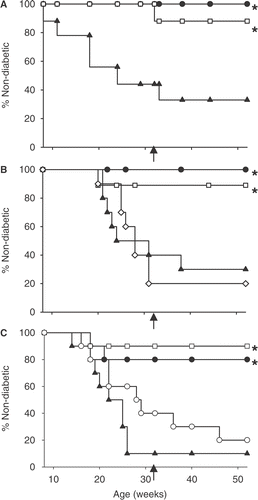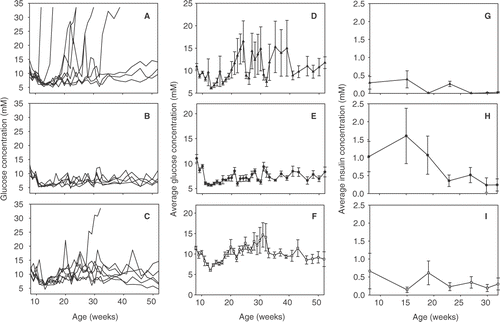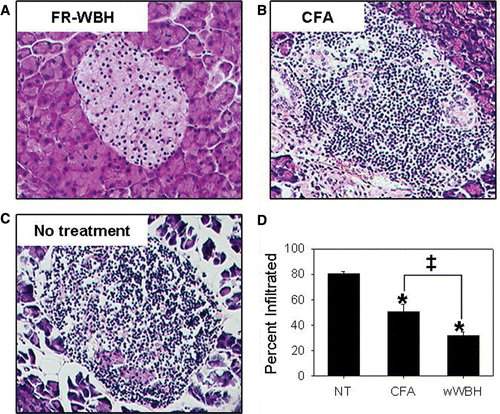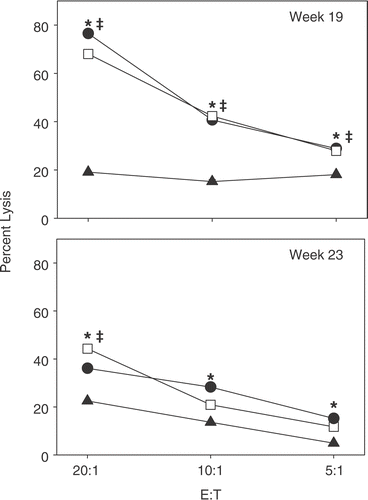Figures & data
Figure 1. Weekly FR-WBH prevents the onset of T1D. Female NOD mice were either left at normothermic temperatures (▴), injected with a single dose of CFA at 8 weeks of age (•), or heated for 6 (B and C) or 8 (A) hours once a week (□; A, B, C), once a month (⋄; B), or once every two weeks (○, C). Percent non-diabetic mice represent those mice with blood glucose levels that were <33.5 mM. Arrow indicates when FR-WBH treatments were terminated. N = 8-10 mice per group in each experiment; *, p ≤ 0.004 when compared to the normothermic group using a log rank statistical test.

Figure 2. Blood glucose concentrations are regulated in weekly FR-WBH treated NOD mice. Female NOD mice were left at normothermic temperatures (A, D, G), injected with a single dose of CFA (B, E, H), or heated for 8 hours once a week from 8-32 weeks of age (C, F, I). Blood glucose measurements were taken once a week for 52 weeks (A–F). Serum insulin measurements were taken once a month until the mice reached 8 months of age (G–I). NOD mice were considered diabetic when blood glucose levels were ≥33.5 mM. (A–C) Each line represents an individual mouse. N = 8–10 mice per group in each experiment.

Figure 3. Pancreatic islets of weekly FR-WBH treated NOD mice demonstrate significantly less lymphocytic infiltration than those of CFA treated mice. Hematoxylin and Eosin staining was performed on pancreatic tissue of normothermic (NT; C), CFA (B), and weekly FR-WBH (A) treated mice and representative images of non-infiltrated and infiltrated pancreatic islets are shown. The percent of lymphocyte infiltrated islets were then quantified in each treatment group. N = 39 age-matched mice in each group; *, p ≤ 0.0217 when compared to normothermic controls using an unpaired Student's t-test; ‡, p = 0.046 when comparing the CFA and weekly FR-WBH groups using an unpaired Student's t-test.

Figure 4. FR-WBH treated NOD mice exhibit greater NK cell cytotoxic activity then normothermic NOD mice that have become diabetic. When normothermic NOD mice became diabetic, splenic NK cells were harvested from the diabetic mouse (▴), as well as age matched non-diabetic, weekly FR-WBH treated (□), or CFA treated (•) mice, and analyzed for lytic activity against NK specific YAC-1 targets. In the case of the FR-WBH treated mice, the glucose measurements and harvesting of splenocytes/cytotoxicity assays were carried out two days after a WBH treatment. Samples collected at 19 (top) and 23 (bottom) weeks of age were examined in triplicat wells to determine mean % lysis +/− S.D., with error bars hidden by symbols. Using an unpaired Student's t-test, p < 0.05 when weekly FR-WBH (‡) and CFA (*) treated splenic NK cells were compared to normothermic controls. Data represent 3 separate experiments at each age.
